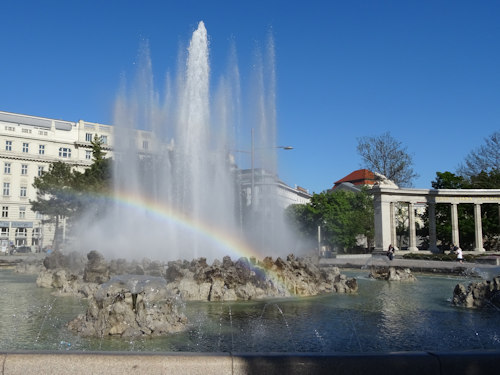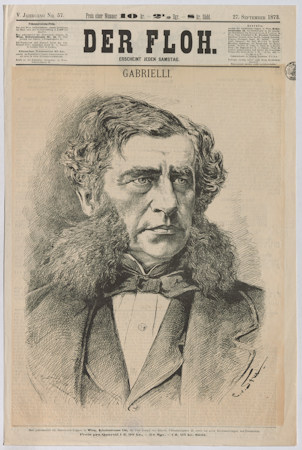
If you miss a cooling coastline on a hot day in Vienna, just stand downwind of the city’s huge Hochstrahlbrunnen fountain for that ocean spray feeling.
- Central fountain that celebrated the opening of a new water pipeline in 1873
- Operates from late March to around late October
- Multicoloured spotlights switch on for the late evening
- See other Viennese fountains:
- The Austriabrunnen
- The Neptune fountain
- The Albrechtsbrunnen
- The Donnerbrunnen
The Hochstrahlbrunnen

(The fountain in its summer glory)
The Hochstrahlbrunnen fountain marks one end of Schwarzenbergplatz square and sits just in front of the giant memorial to the Red Army (the two are purely coincidental neighbours) and not far from the statue to Prince Schwarzenberg himself.
In another example of creative nomenclature to rival Vienna’s Stadtpark recreational area (Stadtpark literally means “city park”), the German name for this water feature translates roughly as “the fountain with tall jets.”
To be fair, whoever picked that name wasn’t wrong. I don’t have the statistics, but this isn’t your gentle fountain with water tinkling over various cheeky cherubs. This is an expression of the power of water.
The Hochstrahlbrunnen actually celebrates a milestone in urban development and city planning: the first direct water pipeline into Vienna from the Alps.
Such an event may sound less than exciting, but the completion of the pipeline in 1873 brought clean water from the mountains to the city with enormous benefits for public health.

(Picture by Franz Kollarz of Emperor Franz Joseph at the big opening event, 1873; Wien Museum Inv.-Nr. W 2506, excerpt reproduced with permission under the terms of the CC0 licence)
Even today, the city’s Alpine pipelines remain the secret behind Vienna’s remarkably high-quality tap water.
The opening of the fountain on October 24th, 1873, actually formed the focal point of the official opening of the pipeline itself.
A report in the Fremden-Blatt paper the day after noted (my translation):
To the sound of music and salvos, the Hochstrahlbrunnen began to work in all its glory, while his majesty the emperor used an eagle’s feather to sign the official document of inauguration on a table in a tent.
The man responsible for building the new water conduit also built and financed the Hochstrahlbrunnen: Anton Gabrielli (pictured below). Please take a moment to admire those sideburns.

(Gabrielli in a portrait by Carl von Stur with zincography by Johann Tomassich, 1873; Wien Museum Inv.-Nr. W 2003; reproduced with permission under the terms of the CC0 licence)
In 1906, the city converted the fountain to a Fontaine lumineuse, i.e. one where the plumes light up in various colours during the night; the authorities replaced the existing lamp technology with energy-efficient LED spotlights in 2013.
Given Vienna’s climate, the fountain only operates during the warmer seasons: typically between March 22nd (World Water Day) and sometime around the end of October. The lights usually switch on between 8pm and midnight, occasionally changing to a different colour pattern in honour of some event or institution.
How to get to the fountain
The Hochstrahlbrunnen sits at the bottom of Schwarzenbergplatz square, though the term “square” feels a bit misleading. Most of this area consists of converging roads and tram lines that leave me begging the SatNav not to take us through it.
This does mean, however, that the location enjoys decent public transport connections.
Subway: take a short walk from Karlsplatz station (U1, U2 and U4 lines). Use exits to the east (e.g. Resselpark) to emerge from the underground station complex on the correct side; walk through the park and past the magnificent Karlskirche church.
Tram/bus: tram 71 passes by one side (get off at Am Heumarkt), tram D the other side (alight at Gußhausstraße).
P.S. Carry on south from the fountain to see the Belvedere complex, home to Baroque palaces, art exhibitions, one of the world’s most expensive paintings, and a few smaller fountains of its own.
Address: Schwarzenbergplatz, 1030 Vienna